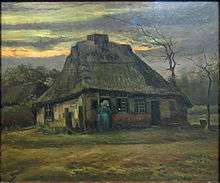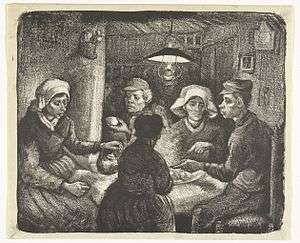The Potato Eaters
| Dutch: De Aardappeleters | |
 | |
| Artist | Vincent van Gogh |
|---|---|
| Year | 1885 |
| Catalog | F82 JH764 |
| Medium | Oil on canvas |
| Dimensions | 82 cm × 114 cm (32.3 in × 44.9 in) |
| Location | Van Gogh Museum, Amsterdam |
The Potato Eaters (Dutch: De Aardappeleters) is an oil painting by Dutch artist Vincent van Gogh painted in April 1885 in Nuenen, Netherlands.[1] It is in the Van Gogh Museum in Amsterdam. A preliminary oil sketch of the painting is at the Kröller-Müller Museum in Otterlo, and he also made lithographs of the image, which are held in collections including the Museum of Modern Art in New York City.
Composition

During March and the beginning of April 1885 he sketched studies for the painting, and corresponded with his brother Theo, who was not impressed with his current work or the sketches Van Gogh sent him in Paris.[3] He worked on the painting from April 13 until the beginning of May, when it was mostly done except for minor changes which he made with a small brush later the same year.
Van Gogh said he wanted to depict peasants as they really were. He deliberately chose coarse and ugly models, thinking that they would be natural and unspoiled in his finished work: "You see, I really have wanted to make it so that people get the idea that these folk, who are eating their potatoes by the light of their little lamp, have tilled the earth themselves with these hands they are putting in the dish, and so it speaks of manual labor and — that they have thus honestly earned their food. I wanted it to give the idea of a wholly different way of life from ours — civilized people. So I certainly don’t want everyone just to admire it or approve of it without knowing why." [4]
Writing to his sister Willemina two years later in Paris, Van Gogh still considered The Potato Eaters his most successful painting: "What I think about my own work is that the painting of the peasants eating potatoes that I did in Nuenen is after all the best thing I did".[5] However, the work was criticized by his friend Anthon van Rappard soon after it was painted. This was a blow to van Gogh's confidence as an emerging artist, and he wrote back to his friend, "you...had no right to condemn my work in the way you did" (July 1885), and later, "I am always doing what I can't do yet in order to learn how to do it." (August 1885).[6]
Versions
 Study for The Potato Eaters, 1885, Kröller-Müller Museum, Otterlo (F78)
Study for The Potato Eaters, 1885, Kröller-Müller Museum, Otterlo (F78).jpeg) Study for The Potato Eaters, 1885, Private collection (F77r)
Study for The Potato Eaters, 1885, Private collection (F77r) Study for The Potato Eaters
Study for The Potato Eaters
Lithograph

Van Gogh made a lithograph of the composition The Potato Eaters before embarking on the painting proper. He sent impressions to his brother, and in a letter to a friend, wrote that he made the lithograph from memory in the space of a day.[7]
Van Gogh had first experimented with lithography in The Hague in 1882. Though he appreciated small scale graphic work and was an enthusiastic collector of English engravings he worked relatively little in graphic mediums.[8] In a letter dated around 3 December 1882 [9] he remarks
- I believe, though, that it would be a great mistake to imagine that such things as, for instance, the print The Grace (a family of woodcutters or peasants at table) were created at a stroke in their final form. No, in most cases the solidity and pith of the small is only obtained through much more serious study than is imagined by those who think lightly of the task of illustrating ...
- Anyway, some paintings in their huge frames look very substantial, and later one is surprised when they actually leave behind such an empty and dissatisfied feeling. On the other hand, one overlooks many an unpretentious woodcut or lithograph or etching now and then, but comes back to it and becomes more and more attached to it with time, and senses something great in it.
Influence of the Hague School
Van Gogh is often associated in people's minds with the Post-Impressionist movement, but in fact his artistic roots lay much closer to home in the artists of the Hague School such as Anton Mauve and Jozef Israëls.
In a letter to his brother Theo written mid-June 1884, Vincent remarks
- When I hear you talk about a lot of new names, it’s not always possible for me to understand when I’ve seen absolutely nothing by them. And from what you said about ‘Impressionism’, I’ve grasped that it’s something different from what I thought it was, but it’s still not entirely clear to me what one should understand by it.
- But for my part, I find so tremendously much in Israëls, for instance, that I’m not particularly curious about or eager for something different or newer.[10]
Before Vincent painted The Potato Eaters Israëls had already treated the same subject in his A Peasant Family at the Table[11] and judging from comment in a letter to Theo 11 March 1882 Vincent had seen this (or at least a variation of it) [12] and had been inspired by it to produce his own version of it. Compositionally the two are very similar:in both paintings the composition of the painting is centered by a figure whose back is turned to us.
Theft
Thieves stole the early version of The Potato Eaters, the Weaver's Interior, and Dried Sunflowers from the Kröller-Müller Museum in December, 1988. In April, 1989, the thieves returned Weaver's Interior in an attempt to gain a $2.5 million ransom.[13] The police recovered the other two on July 14, 1989; no ransom was paid.[14]
On April 14, 1991, the Vincent van Gogh National Museum was robbed of twenty major paintings including the final version of The Potato Eaters. For unknown reasons, the robbers abandoned the art 35 minutes after the robbery, and the paintings were quickly recovered.[15]
References
- ↑ van Tilborgh, Louis (2009). "The Potato Eaters by Vincent van Gogh". The Vincent van Gogh Gallery. Retrieved 2009-09-11.
- ↑ "The Cottage, 1885". Permanent Collection. Van Gogh Museum. 2005–2011. Retrieved 2011-05-15.
- ↑ Naifeh & Smith pp. 439-40
- ↑ "Letter 497". Vincent van Gogh. The Letters. Amsterdam: Van Gogh Museum.
- ↑ McQuillan, 38
- ↑ McQuillan, 20
- ↑ "Letter 516: To Anthon van Rappard. Nuenen, on or about Wednesday, 15 July 1885". Vincent van Gogh. The Letters. Amsterdam: Van Gogh Museum.
- ↑ "Graphic work of Vincent van Gogh". The Vincent van Gogh Gallery. Retrieved 2010-08-23.
- ↑ "Letter 290". Vincent van Gogh. The Letters. Amsterdam: Van Gogh Museum.
- ↑ "Letter 450". Vincent van Gogh. The Letters. Amsterdam: Van Gogh Museum.
- ↑ "Van Gogh Museum - A Peasant Family at the Table". Vangoghmuseum.nl. Retrieved 2014-06-25.
- ↑ "Letter 211". Vincent van Gogh. The Letters. Amsterdam: Van Gogh Museum.
- ↑ Associated Press (1989-04-17). "Thieves Return One Of 3 Stolen Van Goghs".
- ↑ Haden, Anthony (February 28, 2001). "Great Art Thefts Of The 20th Century". Forbes. Retrieved September 21, 2015.
- ↑ Paul L. Montgomery (1991-04-15). "Lost and Found: Huge van Gogh Theft Fails - New York Times". Amsterdam (Netherlands): Nytimes.com. Retrieved 2014-06-25.
Sources
- McQuillan, Melissa. Van Gogh. London: Thames and Hudson, 1989. ISBN 1-86046-859-4
- De La Faille, Jacob Baart (1970). The works of Vincent van Gogh (3rd ed.). Amsterdam: Meulenhoff.
- Hulsker, Jan (1986). The Complete Van Gogh: Paintings, Drawings, Sketches. New York, NY: Harrison House/Harry N. Abrams Distributed by Crown Publishers, Random House. ISBN 0-517-44867-X.
- Naifeh, Steven and Smith, Gregory White. Van Gogh: the Life, New York: Random House, 2011, ISBN 978-0-375-50748-9
External links
| Wikimedia Commons has media related to The Potato Eaters. |
- Van Gogh, paintings and drawings: a special loan exhibition, a fully digitized exhibition catalog from The Metropolitan Museum of Art Libraries, which contains material on this painting (see index)
- The Potato Eaters (1885), oil on canvas, Van Gogh Museum, Amsterdam
- The Potato Eaters (1885), oil on canvas, Kröller-Müller Museum, Otterlo